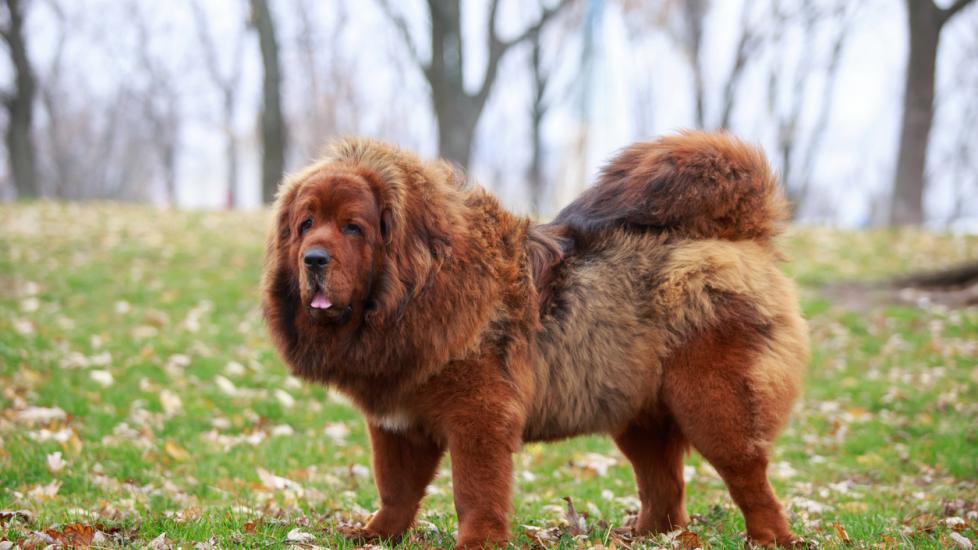Tibetan Mastiff
Tibetan Mastiffs are known for their massive size and lion-like appearance. Originating from Tibet in East Asia, they are an ancient breed (written records date back to 1100 BCE) whose origins are not fully known, according to the American Tibetan Mastiff Association. These historical guardians are aloof but loving and loyal to their family.
The Tibetan Mastiff has a dense, two-layer hair coat consisting of a thick, coarse top coat and a wooly soft undercoat. They are considered a giant dog breed, weighing anywhere between 70–150 pounds with an alert stance, a giant and broad head, recessed eyes, a square-shaped muzzle, a muscular build, and a feathered tail curled up on their back.
Caring for a Tibetan Mastiff
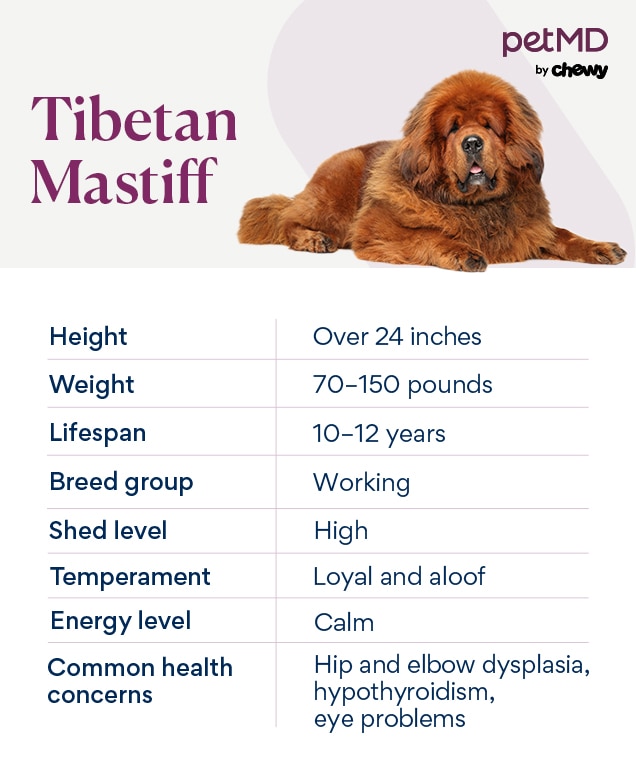
The Tibetan Mastiff displays an aloof, yet alert, temperament and can make a loyal dog. Because of their thick, double-layered hair coat, Tibetan Mastiffs require regular brushing and do not do well in hot weather. Pet parents need to stay alert for signs of heatstroke if they live in warmer areas, or during spring and summer in temperate regions.
Though they are powerful dogs with good agility, Tibetan Mastiffs lack endurance, so they don’t make good jogging partners. They are very intelligent dogs, but they can also be independent-minded and require a job in order to be happy. Socializing a Tibetan Mastiff puppy is very important so they don’t grow up thinking all new animals and people are a danger to their family.
Tibetan Mastiff Health Issues
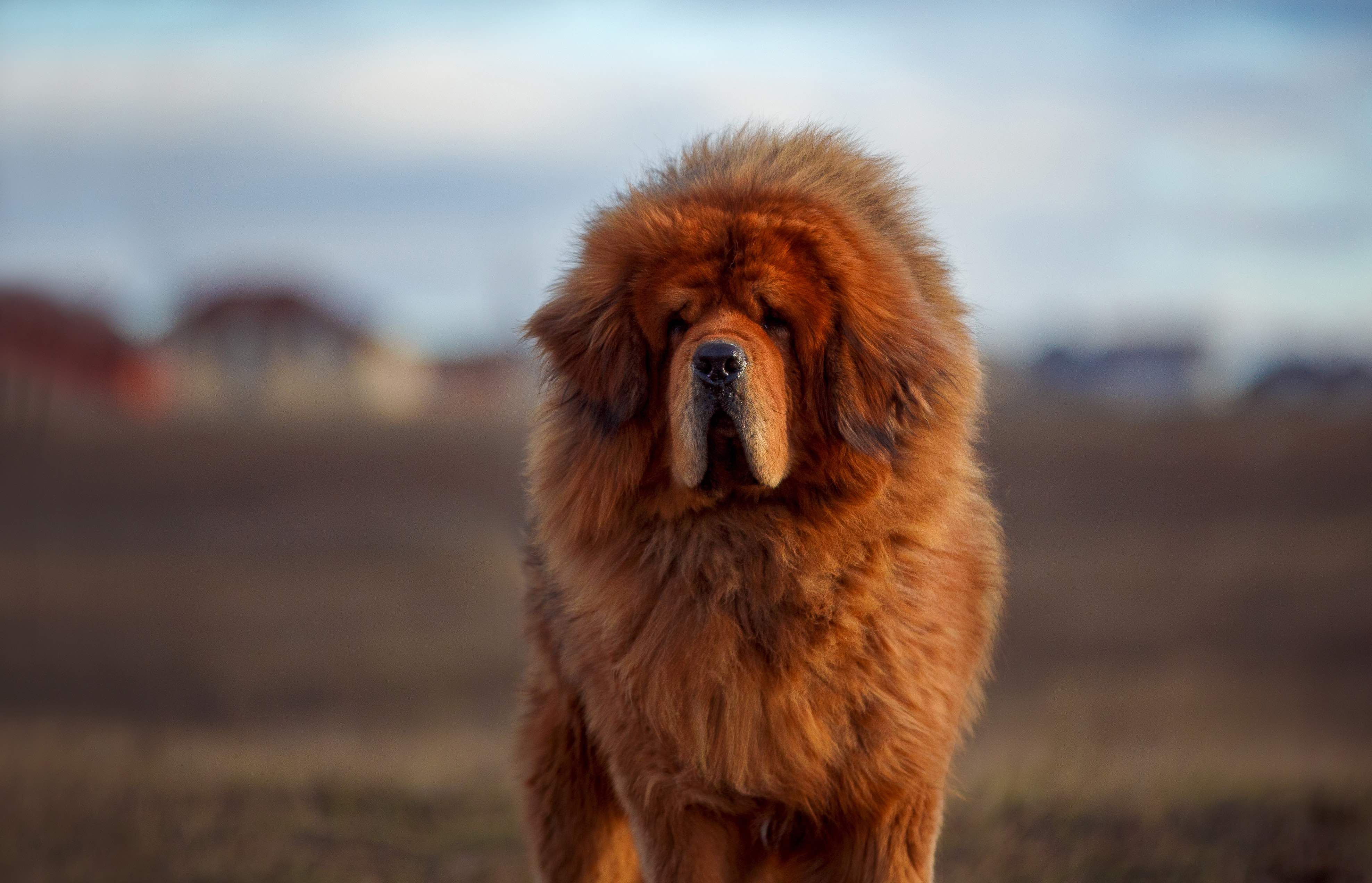
The Tibetan Mastiff has a general life expectancy of 10–12 years. Like many other dog breeds, they can be predisposed to several medical issues, with some of these issues being genetic.
Eye Problems
The most common eye problems for the Tibetan Mastiff include entropion and ectropion. Entropion refers to severe rolling-in of the eyelids (toward the eyeball), while ectropion refers to severe rolling-out of the eyelids (away from the eyeball). The deep-set nature of the Tibetan Mastiff's eyes predisposes them to have these eyelid abnormalities.
Entropion and ectropion can cause other eye problems as well, including:
-
Eye infections
-
Vision problems
-
Corneal ulcer development (tears on the eyeball’s surface)
Surgical correction of entropion and ectropion can permanently correct these eyelid issues.
Elbow and Hip Dysplasia
Elbow dysplasia occurs when there is a problem with the cartilage in the elbow joint or when the bones associated with the elbow joint do not align properly. This mostly affects large and giant dog breeds at a young age, and signs include limping or lameness in the front legs.
Hip dysplasia is a painful condition where the hip joint doesn’t function properly. While there is a genetic predisposition to this condition, lifestyle habits and certain factors can possibly contribute to the development of hip dysplasia, including your Tibetan Mastiff's growth rate, muscle mass, diet, and exercise.
If your dog is diagnosed with elbow or hip dysplasia, options for treatment and long-term management include medications, joint supplements, and surgery. Weight management is also important, because any excess weight will exacerbate the issue and increase discomfort for the dog.
Hypothyroidism
Hypothyroidism is a common dog disease where the thyroid gland does not produce enough thyroid hormones. This disease can be genetic, acquired from an abnormal immune response, or developed from trauma. The lack of thyroid hormones from this disease can affect the body negatively. Pet parents should contact their veterinarian if signs of hypothyroidism are observed, including:
-
Hair and/or skin problems
-
Mental dullness
Hypothyroidism is usually diagnosed with a blood test performed by your veterinarian. This disease is most commonly treated with medication.
What To Feed a Tibetan Mastiff
A Tibetan Mastiff puppy 6–8 weeks old to about 2 years old should be fed a high-quality, large-breed puppy food approved by the Association of American Feed Control Officials (AAFCO). Tibetan Mastiff puppies are slower to mature than other dog breeds, so they should eat puppy food well beyond their first birthday to compensate for their growing bodies.
Once they reach 2 years of age, Tibetan Mastiffs should eat adult-formulated food. Older Mastiffs that are 6–7 years and older should be fed a high-quality senior dog food that’s also AAFCO-approved.
A Tibetan Mastiff involved in agility or other routine exercise should be offered a high-quality dog food with a greater protein content than what would be offered for an average house dog. For a less active Tibetan Mastiff, overfeeding or offering excessive amounts of treats during the day must be avoided to prevent extreme weight gain.
How To Feed a Tibetan Mastiff
As with most other dog breeds, it’s best to feed an adult Tibetan Mastiff twice a day, in the morning and evening. However, many Tibetan Mastiffs are not very food-driven, so it’s not unusual for them to skip a meal, as they only eat when they are truly hungry.
How Much Should You Feed a Tibetan Mastiff?
In general, the amount of dog food offered should be based on the ideal weight of an adult Tibetan Mastiff, which is typically between 70–150 pounds. For most commercial dog foods, you can refer to the feeding guideline on the package. Your veterinarian can also work with you to determine the appropriate amount of food per day for your Tibetan Mastiff.
Nutritional Tips for Tibetan Mastiffs
For a Tibetan Mastiff, consider adding glucosamine and omega-3 supplements (such as fish oil) with their food to promote joint and skin health. There are also some commercial joint health dog foods available, which contain added omega-3 and/or glucosamine.
Behavior and Training Tips for Tibetan Mastiffs
Tibetan Mastiff Personality and Temperament
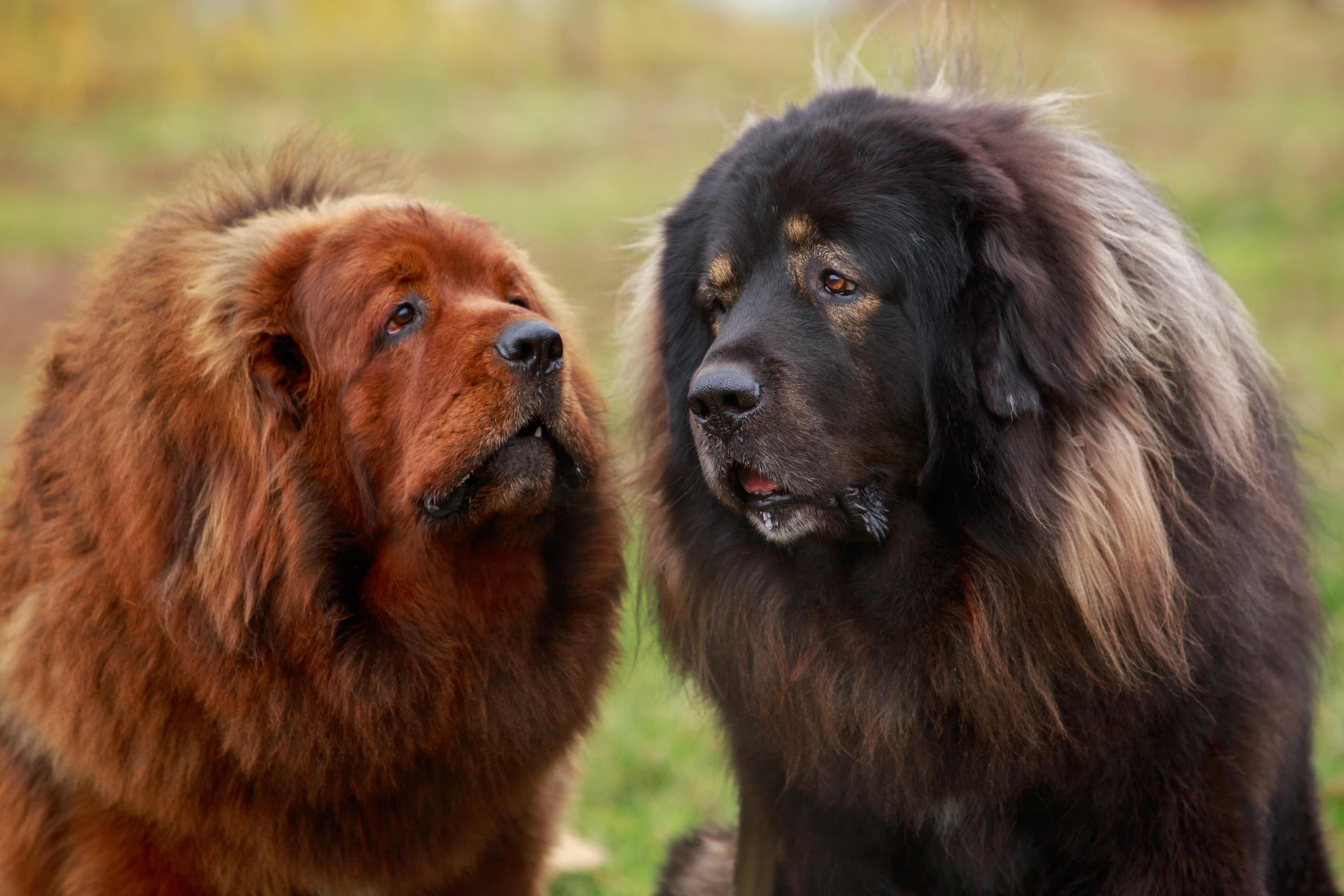
The Tibetan Mastiff displays an aloof, watchful, and alert temperament and can make a loyal family dog. Because they’re so loyal to their family, they can be reserved around strangers and introductions need to be made carefully.
While they can be lazy indoors and sleep during the day, Tibetan Mastiffs are more active at night. They’re fairly quiet dogs but will bark to alert their family if anything seems amiss.
Tibetan Mastiff Behavior
Because of the massive Tibetan Mastiff size and their athletic capabilities, they need moderate exercise and plenty of space to roam and play. They do not do well as an apartment dog; it’s important that these pups have access to a fenced-in yard they can patrol without wandering away. A Tibetan Mastiff that feels confined or bored may become destructive and anxious, resulting in digging and chewing.
Tibetan Mastiff Training
Tibetan Mastiff puppies need to be well-socialized with people and other pets to help them be more accepting of strangers as they age.
While they are highly intelligent and quick to learn, Tibetan Mastiffs can be very willful and might not respond quickly to training. Training must be done with ample positive reinforcement, patience, and persistence.
Fun Activities for Tibetan Mastiffs
-
Guarding livestock
-
Running through the snow
Tibetan Mastiff Grooming Guide
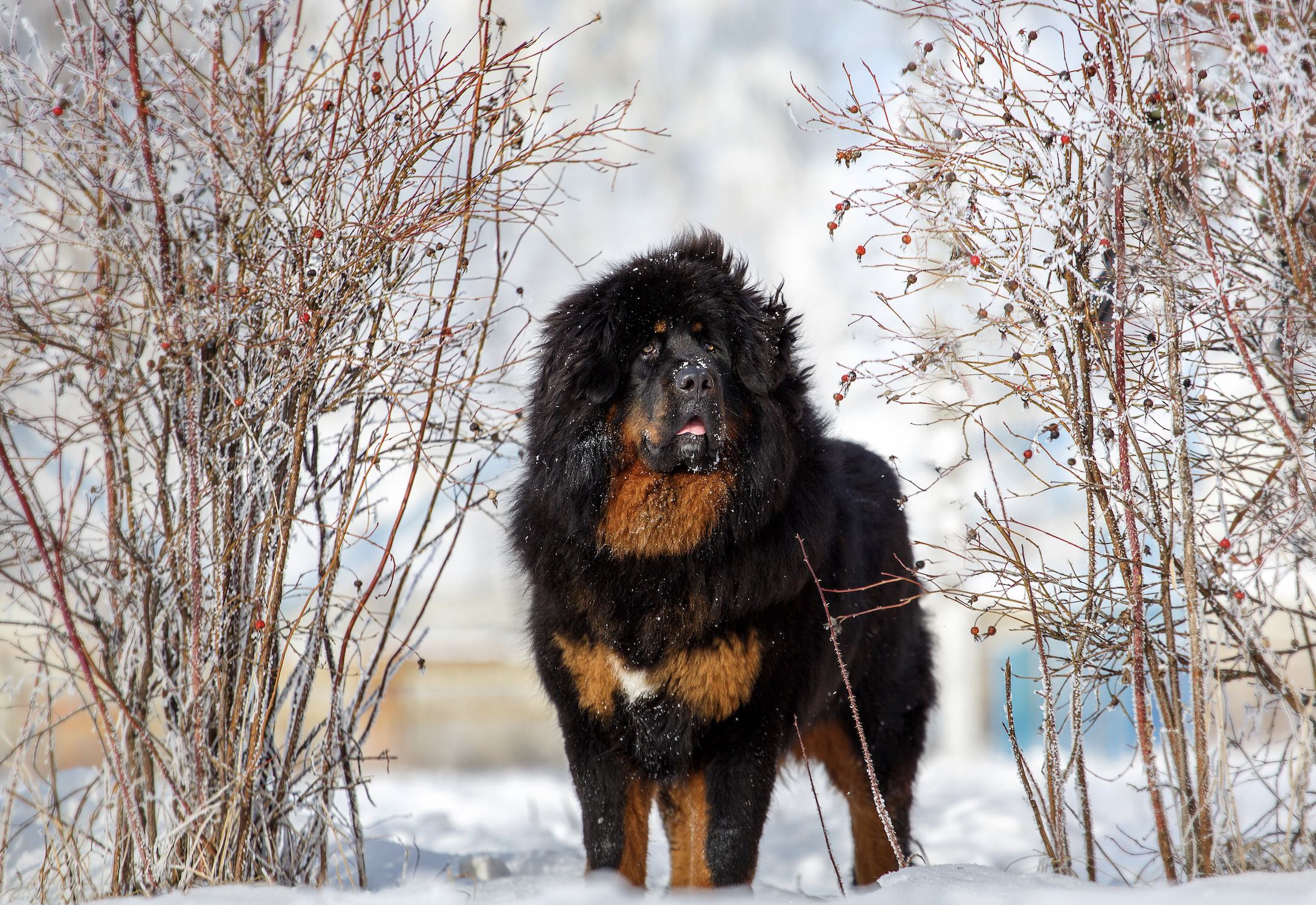
The Tibetan Mastiff has a dense, two-layer coat—a thick, coarse top layer with a wooly, soft coat underneath. This means they require regular brushing, especially when shedding their coat, which happens once or twice a year. During this heavy shedding period, be prepared to deal with lots of flying fluff.
Skin Care
Regular bathing is not required for the Tibetan Mastiff unless they’ve rolled in something smelly or become especially dirty from being outside. Care should be taken to dry the Tibetan Mastiff's coat with a large towel or hair dryer on a low heat setting after bathing. Otherwise, their thick coat can trap moisture and lead to skin infections.
Coat Care
Brushing the Tibetan Mastiff's coat regularly will help keep their hair beautiful and healthy. A deshedding brush (such as the FURminator®) can help remove their excess undercoat, especially during warmer months or when they're shedding their coat for the year.
Eye Care
Because Tibetan Mastiffs are prone to certain eye problems, it's important to have their eyes examined at least once a year by a veterinarian.
Ear Care
After every bath, splashing in water, or rolling around in the yard, pet parents should clean their dog’s ears with a dog-specific ear cleaner so moisture doesn’t become trapped and cause ear infections.
Considerations for Pet Parents
Some of the major considerations for pet parents of a big Tibetan Mastiff include their strong-willed personality, reserved nature around strangers, the need for lots of living space, the importance of early socialization, the high cost of feeding and medicine, and the potential for health problems.
Simply put, a Tibetan Mastiff living in an apartment in a hot area will not thrive nearly as well as one living on a large, fenced-in property in a snowy climate. Pet parents should consider getting pet insurance before bringing home a Tibetan Mastiff puppy to help handle any potential medical costs.
Tibetan Mastiff FAQs
How big are Tibetan Mastiffs?
The Tibetan Mastiff’s size isn’t something to overlook. The males range from 26–29 inches in height and weigh about 90–150 pounds. Female Tibetan Mastiffs, while slightly smaller, are still larger than most other dog breeds; they range from 24–27 inches in height and weigh 70–120 pounds.
Are Tibetan Mastiffs good pets?
Yes! The Tibetan Mastiff is known to be a very loyal family dog. When well-socialized as puppies, Tibetan Mastiffs will be good around children and other pets. However, all interactions between dogs and small kids need to be supervised. It’s not difficult for a Tibetan Mastiff to accidentally knock a child down.
How much does a Tibetan Mastiff cost?
When purchased through a Tibetan Mastiff breeder, puppies can cost as much as several thousand dollars, especially if they have American Kennel Club (AKC) registration. However, there are Tibetan Mastiff rescue organizations that have dogs available for adoption at lower costs. Less commonly, some animal shelters may have Tibetan Mastiff puppies or adults available for adoption.
Featured Image: iStock/DevidDO
